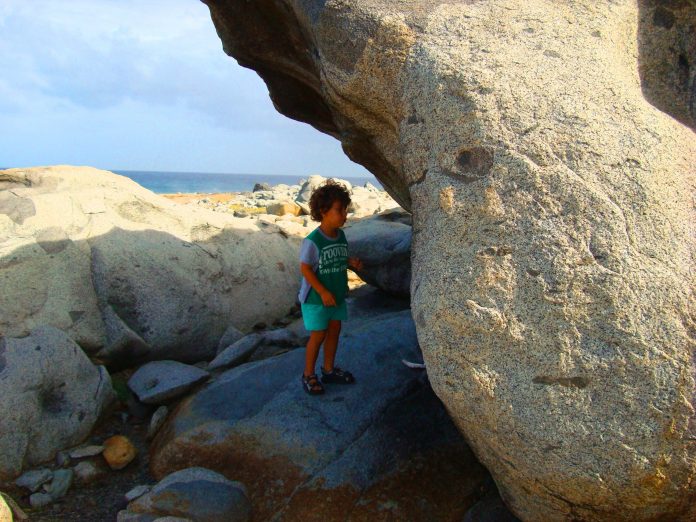Stay in touch with the revelations of “Island-Insights” about the ethnic heritage of the island, which in each weekly episode defends the real identity of our beloved rock called Aruba.
The values of the destination, native heritage, and cultural authenticity are present in this cultural blog as a way to safeguard more reasons to fall in love with Aruba. “Island-Insight” shares awareness, educates, and safeguards native heritage by encouraging the reader to experience an islander’s state of mind. Education breaks down the barriers to greater human understanding, empathy, and empowerment, so today we want to keep you informed about one of the wonderful parts of Aruba’s landscape, “the batholith boulders.”
The term “batholith” comes from the Greek bathos, meaning depth, and lithos, meaning rock. Batholiths, simply put, are the result of molten material rising towards the earth’s surface. This material hardens into granite, and some of this rock finds its way to the surface. The area where they are located is not considered a distinct area unless it covers 40 square miles.
Aruba has three basic geological formations: a limestone part, an undulating part, and the central mountainous part, where the highest elevations of the island are found, including the highest, known as Yamanota 189 m, and the other hills, such as Arikok 184 m.
The limestone part embraces two other zones of the island forming the coastline: some small ancient islands as coral plateaus and canyons of dry rivers. Some formations that will sorely capture your attention will be the rock formations made out of staked boulders recurring throughout the island’s landscape, especially when you tour through the Santa Cruz district. It is a rocky unit landscape named, in geological terms, the Aruba Lava Formation. It is a slightly “undulating” landscape with large boulders that played a very important role in the lives of our prehistoric and agro-ceramic ancestral inhabitants.
The physical characteristics of these large boulders allowed our ancestors to use them as shelters and religious centers, using the smaller rocks as natural water containers and Metate’s to grind all types of cereals and materials for daily use. The hardness and homogeneous structure of the rock made it the best raw material available for these artifacts.
Aruba’s Indigenous Cultural Heritage is meticulously researched, documented, presented, and preserved by Etnia Nativa and associates. An exclusive collection is part of its private museum on permanent display. Many of the objects and items in the collection come from salvage activities and cover an era beginning approximately 4,500 years ago and ending in 1880.
Are you intrigued by the origins and cultural heritage of Aruba?
Do something completely off the tourist grid by visiting a very special private museum where you will be moved by the island’s authentic heritage and experience exhibits of archaeological artifacts, works of art, archaic and lithic artifacts, prehistoric tools, unique artifacts, and colonial furniture.
Etnia Nativa, since 1994, has been a great trendsetter, a living embodiment of blended cultures, and home to our “Island-Insight’s” acclaimed columnist and native artist, who feels a passion for providing visitors an authentic glimpse of Aruba inside his exclusive museum that recreates and introduces you to an authentic glimpse into the island’s cultural legacy.
The colonial family heritage of our columnist, an islander “Piache”, dates back to 1640, when the Dutch occupation began. Meet him and enjoy a genuine native encounter, given that Etnia Nativa comes to mind when an authentic destination experience is requested.
Appointment is required + 297 592 2702 or etnianativa03@gmail.com




















